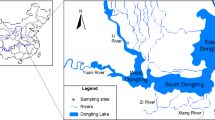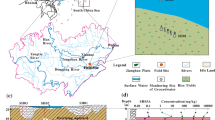Abstract
Nitrogen pollution in wetland ecosystems has become a pressing global issue in recent years. The effects of redox potential on the environmental behavior of nitrogen remain elusive. In the present work, both field experiments and laboratory analyses have been carried out to characterize the spatial-temporal changes of dissolved inorganic nitrogen (NO3−, NO2−, NH4+) and redox potential in the riparian zones of West Dongting Lake Wetland, China. The stability field of groundwater for inorganic nitrogen was represented in an Eh-pH diagram. It is noted that NH4+ is the most abundant species in groundwater when −500 mV < Eh < +300 mV at pH < 9.23; while under oxidizing conditions (Eh > 400 mV), nitrogen is generally in the form of NO3−. The range of both Eh and pH scales was from −381 to 193 mV and from 6.84 to 7.32, respectively, which involved two types of reduction, dissimilatory nitrate reduction to ammonia and denitrification, and the inhibition of the oxidation pathway by nitrification. In groundwater, NH4+ accounted for 50%–90% of the total concentration of dissolved inorganic nitrogen, in accordance with the Eh-pH diagram. This study reveals the severe contamination of groundwater by NH4+ in the riparian zones of Li and Yuan. It provided a theoretical basis to predict nitrogen pollution preliminarily and facilitate management and protection of wetlands.







Similar content being viewed by others
References
APHA (2005) Standard methods for the examination of water and wastewater. American Public Association, Washington, DC, USA
Baas P, Knoepp JD, Markewitz D et al (2017) Areas of residential development in the southern Appalachian Mountains are characterized by low riparian zone nitrogen cycling and no increase in soil greenhouse gas emissions. Biogeochemistry 133(1):113–125
Białowiec A, Davies L, Albuquerque A, Randerson PF (2012) Nitrogen removal from landfill leachate in constructed wetlands with reed and willow: redox potential in the root zone. Journal of Environmental Management 97:22–27
Boomer KMB, Bedford BL (2008) Groundwater-induced redox-gradients control soil properties and phosphorus availability across four headwater wetlands, New York, USA. Biogeochemistry 90(3):259–274
Bowden WB (1987) The biogeochemistry of nitrogen in freshwater wetlands. Biogeochemistry 4(3):313–348
Bowden WB, McDowell WH, Asbury CE et al (1992) Riparian nitrogen dynamics in two geomorphologically distinct tropical rain forest watersheds: nitrous oxide fluxes. Biogeochemistry 18(2):77–99
Brookins DG (1988) Eh-pH diagrams for geochemistry. Springer Science & Business Media, Berlin
Canfield DE, Glazer AN, Falkowski PG (2010) The evolution and future of earth's nitrogen cycle. Science 330(6001):192–196
Cirmo CP, McDonnell JJ (1997) Linking the hydrologic and biogeochemical controls of nitrogen transport in near-stream zones of temperate-forested catchments: a review. Journal of Hydrology 199(1–2):88–120
Cooper AB (1990) Nitrate depletion in the riparian zone and stream channel of a small headwater catchment. Hydrobiologia 202(1–2):13–26
Dwivedi D, Arora B, Steefel CI et al (2018) Hot spots and hot moments of nitrogen in a riparian corridor. Water Resources Research 54(1):205–222
Earl SR, Valett HM, Webster JR (2006) Nitrogen saturation in stream ecosystems. Ecology 87(12):3140–3151
Eckert W, Trüper HG (1993) Microbially—related redox changes in a subtropical lake I. in situ monitoring of the annual redox cycle. Biogeochemistry 21(1):1–19
Elmi AA, Madramootoo C, Egeh M et al (2004) Water and fertilizer nitrogen management to minimize nitrate pollution from a cropped soil in southwestern Quebec, Canada. Water Air and Soil Pollution 151(1–4):117–134
Fetter CW, Boving TB, Kreamer DK (1999) Contaminant hydrogeology. Prentice Hall, Upper Saddle River, NJ
Frindte K, Allgaier M, Grossart HP, Eckert W (2016) Redox stability regulates community structure of active microbes at the sediment–water interface. Environmental Microbiology Reports 8(5):798–804
Galloway JN, Schlesinger WH, Levy H II et al (1995) Nitrogen fixation: anthropogenic enhancement—environmental response. Global Biogeochemical Cycles 9:235–252
Galloway JN, Dentener FJ, Capone DG et al (2004) Nitrogen cycles: past, present, and future. Biogeochemistry 70(2):153–226
Gruber N, Galloway JN (2008) An earth-system perspective of the global nitrogen cycle. Nature 451(7176):293–296
Hancock JT (2019) Considerations of the importance of redox state for reactive nitrogen species action. Journal of Experimental Botany 70(17):4323–4331
Hanson GC, Groffman PM, Gold AJ (1994) Symptoms of nitrogen saturation in a riparian wetland. Ecological Applications 4(4):750–756
Hantschel RE, Kamp T, Beese F (1995) Increasing the soil temperature to study global warming effects on the soil nitrogen cycle in agroecosystems. Journal of Biogeography 22:375–380
Hefting M, Clément JC, Dowrick D et al (2004) Water table elevation controls on soil nitrogen cycling in riparian wetlands along a European climatic gradient. Biogeochemistry 67(1):113–134
Hong J, Zhang J, Ma Y et al (2019) The fates of nitrogen in an experimental wetland food web: a stable isotope study. Wetlands 39(2):303–310
Huang DZ, Wan Q, Li LQ et al (2013) Changes of water quality and eutrophic state in recent 20 years of Dongting Lake. Research of Environmental Sciences 26(1):27–33
Ibrikci H, Cetin M, Karnez E et al (2012) Spatial and temporal variability of groundwater nitrate concentrations in irrigated mediterranean agriculture. Communications in Soil Science and Plant Analysis 43(1-2SI): 47-59.
Kemmitt SJ, Wright D, Goulding KWT et al (2006) pH regulation of carbon and nitrogen dynamics in two agricultural soils. Soil Biology and Biochemistry 38(5):898–911
Kim H, Park S (2016) Hydrogeochemical characteristics of groundwater highly polluted with nitrate in an agricultural area of Hongseong, Korea. Water 8(8):345
Kjellin J, Hallin S, Wörman A (2007) Spatial variations in denitrification activity in wetland sediments explained by hydrology and denitrifying community structure. Water Research 41(20):4710–4720
Kralova M, Masscheleyn PH, Patrick WH Jr (1992) Redox potential as an indicator of electron availability for microbial activity and nitrogen transformations in aerobic soil. Zentralblatt für Mikrobiologie 147(6):388–399
Krause S, Hannah DM, Fleckenstein JH (2009) Hyporheic hydrology: interactions at the groundwater-surface water interface preface. Hydrological Processes23(15): 2103-2107.
Lidman F, Boily Å, Laudon H et al (2017) From soil water to surface water–how the riparian zone controls element transport from a boreal forest to a stream. Biogeosciences 14(12):3001–3014
Lockhart KM, King AM, Harter T (2013) Identifying sources of groundwater nitrate contamination in a large alluvial groundwater basin with highly diversified intensive agricultural production. Journal of Contaminant Hydrology 151:140–154
Ma R, Wang B, Lu S et al (2016) Characterization of pharmaceutically active compounds in Dongting Lake, China: occurrence, chiral profiling and environmental risk. Science of Total Environment 557:268–275
Martin JF, Reddy KR (1997) Interaction and spatial distribution of wetland nitrogen processes. Ecological Modelling 105(1):1–21
Ouedraogo I, Defourny P, Vanclooster M (2016) Mapping the groundwater vulnerability for pollution at the pan African scale. Science of Total Environment 544:939–953
Palta MM, Ehrenfeld JG, Giménez D et al (2016) Soil texture and water retention as spatial predictors of denitrification in urban wetlands. Soil Biology and Biochemtry 101:237–250
Pawar NJ, Shaikh IJ (1995) Nitrate pollution of ground waters from shallow basaltic aquifers, Deccan trap Hydrologic Province, India. Environmental Geology 25(3):197–204
Pett-Ridge J, Silver WL, Firestone MK (2006) Redox fluctuations frame microbial community impacts on N-cycling rates in a humid tropical forest soil. Biogeochemistry 81(1):95–110
Pinay G, Haycock NE (2019) Diffuse nitrogen pollution control: moving from riparian zone to headwater catchment approach—a tribute to the influence of professor Geoff Petts. River Research and Applications DOI. https://doi.org/10.1002/rra.3488
Pinay G, Bernal S, Abbott BW et al (2018) Riparian corridors: a new conceptual framework for assessing nitrogen buffering across biomes. Frontiers in Environmental Science 6:47
Reddy KR, D'angelo EM (1997) Biogeochemical indicators to evaluate pollutant removal efficiency in constructed wetlands. Water Science and Technology 35(5):1–10
Reddy KR, DeLaune RD (2008) Biogeochemistry of wetlands: science and applications. CRC press, Taylor and Francis Group, Boca Raton
Rivett MO, Buss SR, Morgan P, Smith JW, Bemment CD (2008) Nitrate attenuation in groundwater: a review of biogeochemical controlling processes. Water Research 42(16):4215–4232
Serio F, Miglietta PP, Lamastra L et al (2018) Groundwater nitrate contamination and agricultural land use: a grey water footprint perspective in southern Apulia region (Italy). Science of Total Environment 645:1425–1431
ŠImek M, Cooper JE (2002) The influence of soil pH on denitrification: progress towards the understanding of this interaction over the last 50 years. European Journal of Soil Science 53(3):345–354
Small GE, Cotner JB, Finlay JC et al (2014) Nitrogen transformations at the sediment–water interface across redox gradients in the Laurentian Great Lakes. Hydrobiologia 731(1):95–108
Smith RL, Bohlke JK, Song B et al (2015) Role of anaerobic ammonium oxidation (anammox) in nitrogen removal from a freshwater aquifer. Environmental Science and Technology 49(20):12169–12177
Spalding RF, Exner ME, Lindau CW et al (1982) Investigation of sources of groundwater nitrate contamination in the Burbank-Wallula area of Washington, USA. Journal of Hydrology 58(3–4):307–324
Steffen W, Richardson K, Rockström J, Cornell SE, Fetzer I, Bennett EM, Biggs R, Carpenter SR, de Vries W, de Wit CA, Folke C, Gerten D, Heinke J, Mace GM, Persson LM, Ramanathan V, Reyers B, Sörlin S (2015) Planetary boundaries: guiding human development on a changing planet. Science 347(6223):1259855
Swanson FJ, Gregory SV, Sedell JR et al (1982) Land-water interactions: the riparian zone. In: Edmonds RL (ed) Analysis of coniferous Forest ecosystems in the Western United States. Hutchinson & Ross, Inc., Stroudsburg, PA, pp 267–291
Tokarz E, Urban D (2015) Soil redox potential and its impact on microorganisms and plants of wetlands. Journal of Ecological Engineering 16(3):20–30
Vitousek PM, Aber JD, Howarth RW et al (1997) Human alteration of the global nitrogen cycle: sources and consequences. Ecological Applications 7(3):737–750
Wang L, Liang T, Zhong B et al (2014) Study on nitrogen dynamics at the sediment–water interface of Dongting Lake, China. Aquatic Geochemistry 20(5):501–517
Wang L, Stuart ME, Lewis MA et al (2016) The changing trend in nitrate concentrations in major aquifers due to historical nitrate loading from agricultural land across England and Wales from 1925 to 2150. Science of Total Environment 542:694–705
Wang W, Yuan W, Chen Y et al (2018) Microplastics in surface waters of Dongting lake and Hong lake, China. Science of Total Environment 633:539–545
Wang S, Wang W, Zhao S et al (2019) Anammox and denitrification separately dominate microbial N-loss in water saturated and unsaturated soils horizons of riparian zones. Water Researcg 162:139–150
Winkler P, Kaiser K, Jahn R et al (2019) Tracing organic carbon and microbial community structure in mineralogically different soils exposed to redox fluctuations. Biogeochemistry 143(1):31–54
Yu Y, Mei X, Dai Z et al (2018) Hydromorphological processes of Dongting Lake in China between 1951 and 2014. Jounal of Hydrology 562:254–266
Yuan Y, Zeng G, Liang J et al (2015) Variation of water level in Dongting Lake over a 50-year period: implications for the impacts of anthropogenic and climatic factors. Journal of Hydrology 525:450–456
Zhai Y, Lei Y, Wu J, Teng Y, Wang J, Zhao X, Pan X (2017) Does the groundwater nitrate pollution in China pose a risk to human health? A critical review of published data. Environmental Science and Pollution Research 24(4):3640–3653
Zhao S, Zhou N, Liu X (2016a) Occurrence and controls on transport and transformation of nitrogen in riparian zones of Dongting Lake, China. Environmental Science and Pollution Research 23(7):6483–6496
Zhao S, Zhou NQ, Shen XP (2016b) Driving mechanisms of nitrogen transport and transformation in lacustrine wetlands. Science China-Earth Science 59(3):464–476
Zhi G, Chen Y, Liao Z et al (2016) Comprehensive assessment of eutrophication status based on Monte Carlo–triangular fuzzy numbers model: site study of Dongting Lake, mid-South China. Environmental Earth Sciences 75(12):1011
Zhou N, Zhao S, Shen X (2014) Nitrogen cycle in the hyporheic zone of natural wetlands. Chinese Science Bulletin 59(24):2945–2956
Acknowledgements
The author thanks the editor and anonymous reviewers for their comments on this manuscript. This study was financially supported by the National Natural Science Foundation of China (No.41702241).
Author information
Authors and Affiliations
Corresponding author
Ethics declarations
Conflict of Interest
The authors declare that they have no competing interests.
Additional information
Publisher’s Note
Springer Nature remains neutral with regard to jurisdictional claims in published maps and institutional affiliations.
Rights and permissions
About this article
Cite this article
Zhao, S., Zhang, B. & Zhou, N. Effects of Redox Potential on the Environmental Behavior of Nitrogen in Riparian Zones of West Dongting Lake Wetlands, China. Wetlands 40, 1307–1316 (2020). https://doi.org/10.1007/s13157-020-01301-9
Received:
Accepted:
Published:
Issue Date:
DOI: https://doi.org/10.1007/s13157-020-01301-9




